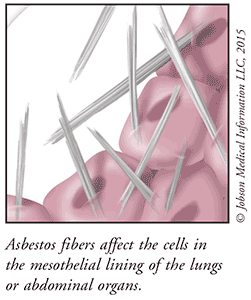US Pharm. 2015;40(7):13-14.
Cancer Caused by Asbestos Exposure
Malignant mesothelioma is a rare and deadly cancer that affects the cell lining (mesothelium) of the lung, abdomen, or other organs. Almost all cases of mesothelioma can be linked to heavy exposure to asbestos. Asbestos is a combination of minerals and other elements that bond together to form tiny fibers. The asbestos fibers can enter the body by inhalation or swallowing.
The symptoms of mesothelioma take many years to appear, and the cancer is usually quite advanced at the time of diagnosis. Standard treatment with surgery, chemotherapy, and radiation is not very effective. New treatments are being studied to help increase the survival rates in patients with mesothelioma.

Often Not Diagnosed Until the Disease Is Advanced
Malignant mesothelioma is a relatively rare cancer. In the United States, only a few thousand cases are diagnosed each year. The two most common kinds of mesothelioma are found in the tissue that lines the lungs (pleural mesothelioma) or, less frequently, the abdomen (peritoneal mesothelioma).
The majority of people diagnosed with mesothelioma were heavily exposed to asbestos 30 to 50 years before their symptoms appeared. As a result, most people with mesothelioma are men over age 65 years who were exposed many years ago in the workplace.
Dangers of Asbestos
Asbestos is a natural combination of minerals and elements found in rocks and soil. It is fiber that, once inhaled or swallowed, settles in the lungs or stomach. The fiber is an irritant, and it affects the cells in the mesothelial lining of the lungs or abdominal organs.
Asbestos is naturally heat and fire resistant. It was used for 50 years in manufacturing insulation, shingles, flooring, automobile brakes, and similar products prior to the 1990s. As a result, miners and workers in plants that manufactured shingles, insulation, cement products, flooring, or brake linings are the people most highly affected by asbestos-related diseases, including scarring, lung cancer, and mesothelioma. Others at risk for asbestos-related diseases include workers who installed materials made with asbestos and people who lived with someone working around high levels of asbestos. The asbestos fibers in the workplace were easily brought home on the skin and clothes of the workers. Today, asbestos is not used frequently in manufacturing, and when it is, proper precautions are taken to protect workers and their families from asbestos exposure.
Late-Stage Diagnosis
The symptoms of mesothelioma are similar to those of many other conditions, so early diagnosis is difficult. Symptoms of mesothelioma of the lungs include shortness of breath, pain in the chest wall under the ribs, lumps under the skin on the chest, cough, and difficulty swallowing. Abdominal mesothelioma can cause pain, swelling, and lumps of tissue under the abdominal wall. As with any cancer, mesothelioma can cause weight loss and unexplained fatigue.
Discovery and diagnosis of mesothelioma are often made when the disease is advanced. Nonspecific symptoms that do not go away are eventually examined closely to identify their cause. Blood tests and imaging studies such as CT, MRI, or PET scans can be useful. If appropriate, a physician specialist will perform a biopsy to examine a sample of tissue from the affected area. When mesothelioma is diagnosed, the stage of cancer can be determined and the appropriate treatment planned.
Mesothelioma is not an easy cancer to treat because it is discovered at a late stage. Chemotherapy, radiation, and surgery may be useful depending on the patient’s age and general health. The choice of treatment also depends on the stage, or extent, of the cancer. The goal of treatment is often to extend life and keep the patient comfortable, not to achieve remission or a cure.
Avoiding Exposure
The majority of mesothelioma cases are preventable. Asbestos is found in many homes and buildings constructed in the U.S. from the 1940s through the 1990s. If asbestos is left intact, it does not pose a hazard. If it is disturbed by building renovation or destruction, however, tiny asbestos fibers can float through the air and enter the lungs without appropriate protection. To avoid human exposure, asbestos should be removed only by an experienced contractor.
To comment on this article, contact rdavidson@uspharmacist.com.





